Snails (Gastropoda)
Organs and Organ Systems

Schematic
overview of a snail's anatomy:
1: Shell; 2: Digestion gland; 3:
Lung; 4: Anus; 5:
Respiratory hole; 6: Eye; 7:
Tentacle; 8: Cerebral
ganglion; 9: Salivary duct; 10: Mouth; 11: Oesophagus; 12:Salivary gland;
13: Genital pore; 14: Pe-
nis; 15: Vagina; 16: Mucus glands; 17: Oviduct; 18: Dart sac; 19: Foot; 20:
Stomach; 21: Kidney;
22: Mantle; 23: Heart; 24: Spermioduct (Vas deferens). Source: Wikipedia. |
Of all molluscs, the snails have adapted to the most habitats, which has led
to their amounting to the by far highest number of mollusc species. Adaptation to
so many different habitats only way possibly by optimally adapting organs and
organ systems. Alone from external appearance, two gastropod species may
sometimes be hard to recognise as two of the same class, Gastropoda.
Respiration
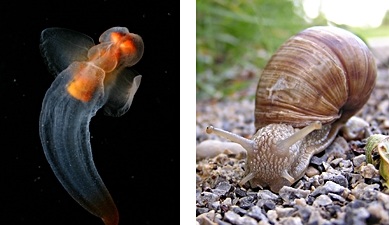
Different in every regard, but nevertheless both are gastropods.
Left: Sea angel (Clione
limacina), right: Roman snail (Helix pomatia).
Pictures: Kevin Raskoff (Source),
left, and Cornelia Kothmayer (right). |
|
Respiration is one of the characters very
different between snail groups. Basically there are pulmonate snails, whose
pallial cavity is formed to a simple lung to breathe oxygen from the air. Among
those there are most of the terrestrial snails, as well as pulmonate snails
living in fresh water.
| |
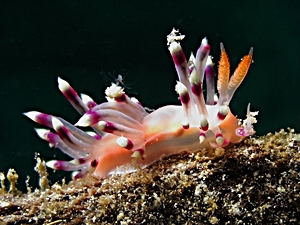
The marine nudibranch
Flabellina exoptata (Aeolidia) from
Malaysia.
Picture: Choh Wah Ye (Source). |
Other gastropod species have developed the ability to breathe air later. All
marine gastropods, as well as some fresh water gastropods, breathe with gills.
Snails originally possess the so-called comb-gills (ctenidia), which are also
located in the pallial cavity. An exception are the marine
nudibranchs (Nudibranchia),
whose original gills have been reduced, so the nudibranchs breathe using newly
developed feathery dorsal appendages called cerata.
 Respiration and circulation
of the Roman snail.
Respiration and circulation
of the Roman snail.
Circulation and Excretion
A snail's circulation basically is open. That means that snails may have some
important blood vessels, such as the pulmonary vein, leading from the lung to
the heart, and the main artery or aorta, but the blood circulates freely between
the organs. There it mixes with the lymphatic fluid, resulting in the so-called
haemolymph. A snail's heart has two chambers, one ventricle and one atrium. It
is located in the heart bag, the so-called pericardium.
The heart bag is also important to the snail's excretion, meaning the
disposal of indigestible material usually rich in nitrogen. In the most
primordial gastropod species, filtration takes place through the heart bag's
wall, the excretion taking place afterwards via an efferent channel, the urethra.
Snails' excretion organs originally were derived from the segmented worms' (Annelida)
metanephridia.
While water snails excrete a very much diluted primary urine, terrestrial
pulmonate snails have developed the ability to resorb most of the water. In
terrestrial snails, excretion takes place in a kidney, whose interior surface
has been increased by many interior walls called septae. Through their walls
filtration of blood flowing through takes place. Terrestrial snails usually
excrete urea, containing almost no water.
Nutrition
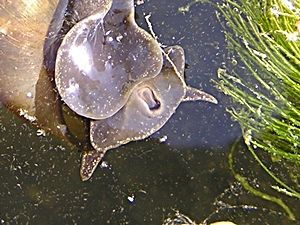
A pond snail (Lymnaea stagnalis) grazing the algae on the
water surface. Note the visible radula!
[RN] |
|
As different as the methods of nutrition may be among snails (there are
herbivores, omnivores and carnivores), it can nonetheless be retraced to common
organs. To feed, snails use an organ, that is present in most molluscs and
unique in the animal kingdom: The radula or a rasp tongue. Basically, it consists
of an elastic band running over a gristle core and armed with a large number of
chitin teeth. To feed, this rasping band is used like the transportation band of
a bucket excavator, food particles rasped of are transported back into the
gullet. The bow-shaped jaw is used to cut off food particles.
| |
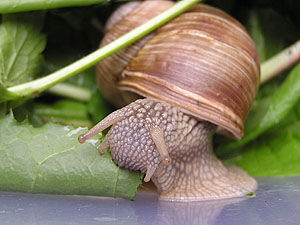
A Roman snail eating a leaf of green food. It pulls the leaf into
its mouth using the radula and then cuts it off with the jaw.
[RN] |
Similar to other animals' teeth, the radula as well is adapted strongly to
the respective methods of nutrition. While plant-eating species, such as the
Roman snail, have broad and blunt radula teeth, predatory snails usually have
dagger or lance shaped radula teeth, enabling them to hold the prey and also to
rip flesh from it (fittingly, a
predatory snail from the American Northwest is
called the Robust lancetooth - Haplotrema vancouverense).
Maximally adapted to the method of hunting and feeding is the radula of
cone shells (Conidae):
While elsewhere the radula carries thousands of teeth, cone shells only have one
at a time, formed like a harpoon and used to inject the prey with venom. In
marine gastropods, the radula is also often used for systematic purposes, which
is why the difference is made between beam-tongue gastropods (Docoglossa,
among them the limpets - Patellidae) or
the venom-tooth gastropods (Toxoglossa, as expected, among others the
cone shells - Conidae).
 Radula Types.
Radula Types.
Two salivary gland open into the gullet, which are used to digest food for
the first time. In cone shells, they have been transformed into venom glands. A
snail's stomach is a simple blind sac, in which the digestion by saliva
continues. The main part of digestion takes place in the main digestive gland, a
specialised gland taking most of the place in the visceral sac. It is also
called a hepatopancreas, being both liver and pancreas. While usually
the liver only produces digestive fluids and stores nutrients, in a snail's hepatopancreas also digestion takes place. Also, lime is gained from the food,
later transported via the blood stream to the shell-building cells of the mantle.
 Nutrition of snails.
Nutrition of snails.
 Nutrition of the Roman snail.
Nutrition of the Roman snail.
Nervous system
| |

Prof. Eric Kandel with a sea hare (Source). |
The nervous system of gastropods is located at the ventral side and can be
derived from the segmented worms' (Annelida) rope-ladder nervous system. While
in very primordial gastropods, nerve knots (ganglia) are still placed in
different parts of the body (the foot ganglion, the visceral ganglion, the
pleural ganglion etc.), the nervous system of more advanced gastropod species,
especially of terrestrial pulmonate snails, is very much centralised, all
ganglia molten to form one common ring around the gullet, called the buccal mass.
Especially more advanced gastropod species are capable of rather astonishing
neural feats - the marine slug Aplysia,
for example, was used to research learning behaviour and conditioning.
 Nervous system of snails.
Nervous system of snails.
Reproduction
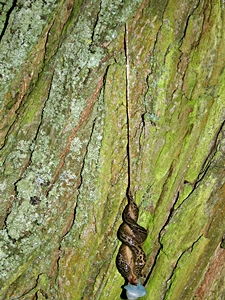
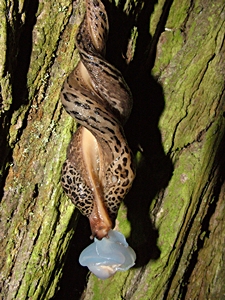
Mating of the leopard slug (Limax maximus). Pictures: T. Hiddessen. (Wikipedia). |
|
While basically snails have separate sexes, terrestrial
pulmonate snails (Stylommatophora)
are hermaphrodites, both male and female. So are some fresh water snails and the
marine opisthobranchs (Opisthobranchia),
altogether by far the largest part of all snails.
The hermaphroditic snails posses male and female, as well
as hermaphroditic organs in one common
genital apparatus.
Mating can be quite an interesting view in terrestrial
snails. So for example leopard slugs (Limax maximus)
mate hanging freely in mid air from a slime thread. In contrary to them, Roman
snails mate on the ground, but their mating procedure may take several hours.
Also, during the process, a love dart may be
applied. Among the hermaphroditic Roman snail, copulation takes place afterwards
simultaneously and vice-versa.
In terrestrial snails, the embryonic development
of the young then takes place in the egg after fertilisation and
oviposition. From the
egg, complete young snails hatch, which have to grow, but which also have a
complete set of organs and a shell.
On the other hand, some water snails, but especially the
marine gastropods, reproduce via several larval stages (Trochophora and Veliger
larvae), which swim freely or float in the water as part of the plankton.
 Reproduction of snails.
Reproduction of snails.
 Reproduction of the
Roman snail.
Reproduction of the
Roman snail.







